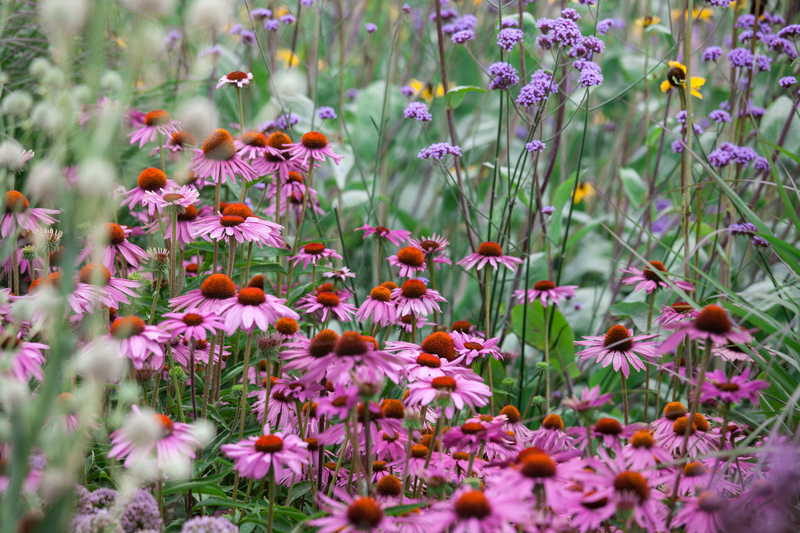The Art of Preserving Garden Plants in the Cold Months
Posted on 31/08/2025
The Art of Preserving Garden Plants in the Cold Months
For every passionate gardener, one unavoidable challenge is protecting cherished garden plants from the biting cold and frost of winter. As temperatures plummet and daylight diminishes, plants that flourished during the warmer months face significant stress. Successfully preserving plants through the cold months is a true art form, blending horticultural skill, foresight, and resourcefulness.
Understanding the Challenges of Winter Gardening
Winter brings a unique set of pressures and threats to garden plants. Whether you are growing in a temperate climate with occasional frosts or in a region blanketed by heavy snow and ice, winter preservation techniques are essential. The main challenges include:
- Frost damage that can kill delicate foliage and stems
- Sustained cold spells that freeze the ground and root systems
- Reduced sunlight which slows plant metabolism
- Dehydration as frozen soil restricts water access
- Wind burn that strips precious moisture from leaves and stems
Knowing how to preserve your garden plants during cold months is the first step to nurturing a thriving garden all year round.

Best Techniques for Preserving Garden Plants in Winter
1. Mulching: Nature's Insulating Blanket
Applying mulch is among the most effective ways to preserve your plants during winter. A generous layer of mulch insulates the soil, maintains more consistent ground temperatures, and helps retain crucial moisture. Organic mulches, such as straw, pine needles, shredded leaves, or wood chips, offer added benefits by breaking down and enriching the soil over time.
- Apply 2-4 inches of mulch around the base of plants, extending out to the drip line.
- Avoid piling mulch directly against plant stems or tree trunks to prevent rot.
- Remove some mulch in early spring as temperatures rise to allow the soil to warm up.
2. Cloches and Row Covers: Extending Protection
For preserving delicate garden plants like young vegetables, herbs, or flowering annuals, physical barriers offer excellent frost protection. Garden cloches, made from glass or plastic, act as mini-greenhouses, trapping warmth and providing a shield from wind and frost. Row covers--either lightweight floating fabrics or heavier polyethylene sheeting--can be draped over beds to create a protective microclimate.
- Support row covers with hoops to prevent them from crushing plants.
- Ventilate covers on sunny days to avoid overheating.
- Use cloches for individual or small groups of prized plants.
3. Watering Strategies Before the Freeze
Despite the cold, dehydration is a real threat in winter. As the ground freezes, roots can no longer absorb moisture, leading to winter desiccation. To combat this:
- Water thoroughly before the first hard frost, especially for evergreen shrubs and newly planted trees.
- Ensure soil drains well to prevent waterlogging and rot.
- Reduce watering once the ground is frozen but monitor potted plants in sheltered spots, as they may dry out.
4. Pruning for Strength and Survival
Pruning plays a vital role in winterizing garden plants. Remove weak, diseased, or dead branches in early autumn to reduce the weight and wind resistance during snow or ice storms. For some species, light pruning after the first frost can encourage branching and make them less prone to winter breakage.
- Use sharp, sanitized tools to make clean cuts.
- Avoid heavy pruning in late autumn, as it can stimulate new growth vulnerable to freezing.
- Prune away any crossing branches to reduce damage from wind-rubbing.
5. Wrapping and Windbreaks: Defending Against Harsh Elements
Some garden plants benefit from extra protection with physical wraps or windbreaks. Trees and shrubs, particularly young or sensitive varieties, can suffer from winter burn caused by icy winds and freezing temperatures.
- Wrap trunks of young trees with burlap or tree wrap to prevent sunscald and frost cracks.
- Create windbreaks using fences, hedges, or artificial screens to shield exposed plantings.
- Bundle evergreen branches loosely with twine to support them during heavy snow.
6. Transplanting and Container Gardening in Cold Months
Potted plants, tropicals, and frost-tender perennials require special attention during the cold months. Consider transplanting vulnerable varieties into containers that can be moved to sheltered spots.
- Relocate pots to a garage, shed, or enclosed porch where they receive indirect light.
- Group containers together for mutual thermal protection.
- Insulate pots with bubble wrap, burlap, or foam to prevent root freezing.
Specialized Tips for Preserving Different Types of Garden Plants
Preserving Flowering Perennials Through Winter
Many perennials are naturally adapted to survive the colder months, but additional steps can greatly enhance their winter resilience. Cut back dead foliage after it browns, but leave 2-3 inches above the crown to prevent moisture from seeping in and causing rot. For especially tender perennials, consider lifting the roots and storing them indoors in slightly moist peat moss or sawdust.
Protecting Shrubs and Trees
When temperatures fluctuate between freezing and thawing, trees and shrubs are at risk of bark splitting, winter burn, and root injury. To safeguard them:
- Mulch heavily over root zones.
- Wrap young trees and shrubs with burlap or protective tree wraps.
- Water well in the fall.
- Check supports and stakes to ensure stability.
Overwintering Bulbs and Corms
Not all bulbs can survive in-ground through severe winters. Lift tender varieties such as dahlias, gladiolus, and begonias after the foliage dies back. Cure them in a dry location, remove soil, and store in cool, dry, and dark conditions until replanting in spring. Hardy bulbs like tulips, daffodils, and crocuses can often be left in the soil, but benefit from a mulch layer for insulation.
Vegetable Gardens and Cold Frames
Cold frames and hoop houses can extend your growing season for veggies deep into the cold months. Root vegetables (carrots, parsnips), leafy greens (kale, spinach), and alliums (leeks, garlic) frequently perform well with additional protection.
- Keep frames vented on sunny days to avoid overheating.
- Use lightweight row covers for added insulation and pest protection.
- Harvest crops promptly to prevent freezing inside the ground.
The Role of Plant Selection in Winter Gardening Success
The art of preserving your garden in cold months begins well before the first frost--with smart plant selection. Whenever possible, choose plants that are suited to your USDA Hardiness Zone and local climate conditions. Native plants and species bred for cold tolerance are naturally equipped to survive seasonal swings.
- Research plant hardiness ratings before buying or planting.
- Incorporate evergreens and native shrubs for year-round structure.
- For Mediterranean herbs like rosemary, select hardier cultivars or plan for overwintering indoors.
Maintaining Soil Health During Winter
Healthy soil is the backbone of resilient winter gardens. Cold weather slows down the decomposition of organic matter, so it's crucial to bolster soil fertility before the ground freezes.
- Amend beds with compost in fall to support root growth and beneficial microorganisms.
- Cover crops such as clover or winter rye can be planted in empty beds to prevent erosion and add nutrients when tilled under in spring.
- Avoid walking on frozen beds to prevent compaction and root damage.
Common Mistakes to Avoid When Preserving Garden Plants in Cold Months
Even seasoned gardeners can make errors that jeopardize their plants. Some common pitfalls to avoid include:
- Applying fertilizer too late in the season, encouraging growth that is then damaged by frost.
- Neglecting to water evergreen shrubs before winter, making them prone to desiccation.
- Piling mulch too close against plant stems, leading to rot and disease.
- Improper pruning timing that triggers new, frost-susceptible growth.
- Forgetting to remove or vent protective covers on warm winter days, which can cause overheating and fungal issues.
Creative Approaches and Advanced Preservation Strategies
Microclimates and Strategic Planting
Leverage your garden's natural microclimates to protect tender species. Planting sensitive varieties near south-facing walls, under larger canopy trees, or in sheltered courtyards can afford a few extra degrees of warmth, improving winter survival rates.
Heated Greenhouses and Indoor Growing
For gardeners passionate about rare or tropical plants, a heated greenhouse or indoor growing area can be invaluable. Even unheated greenhouses provide significant frost protection, especially when supplemented with thermal mass such as water barrels or stone flooring.
Thermal Blankets and Horticultural Fleece
Modern textile technology has revolutionized plant coverage. Lightweight frost protection blankets and horticultural fleece offer high insulation while allowing light and moisture to penetrate. These can be quickly deployed during sudden cold snaps or snowstorms.
The Benefits of Successfully Preserving Garden Plants
Mastering the art of preserving garden plants in winter offers year-round rewards:
- Reduces plant replacement costs in spring
- Encourages earlier blooms and harvests
- Supports ecosystem health and local wildlife
- Enhances overall garden resilience
- Fosters gardening confidence and proficiency
Preservation Myths and Frequently Asked Questions
Myth: All Plants Need Heavy Mulching
While mulching is highly effective, not all plants benefit from thick mulch layers. Some perennials require drier roots and can rot under excess moisture. Always check cultural recommendations before mulching.
Myth: Watering Is Not Necessary in Winter
Even dormant plants lose water through transpiration. Check soil moisture regularly for evergreens and water during dry, unfrozen spells.
Q: Can I Leave Pots Outside All Winter?
Only use frost-proof containers and hardy plants. For added safety, group pots together, wrap them for insulation, or move them to sheltered spots.

Conclusion: Cultivating Resilience With the Art of Plant Preservation
Preserving garden plants through the cold months is a rewarding endeavor that keeps your hard work and cherished green spaces thriving until spring's warm return. By combining proven horticultural techniques--such as mulching, protective covers, strategic watering, and smart plant selection--you can safeguard your landscape against winter's harshest threats.
Whether tending a small urban oasis or a sprawling country garden, embrace the art of winter plant preservation as an opportunity to nurture, plan, and savor the beauty of nature in every season. Your efforts will be repaid with lush growth, vibrant blooms, and a flourishing garden that defies even the coldest winter months.

